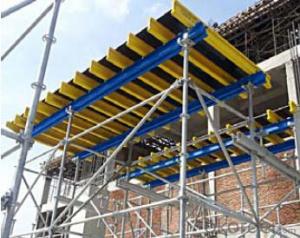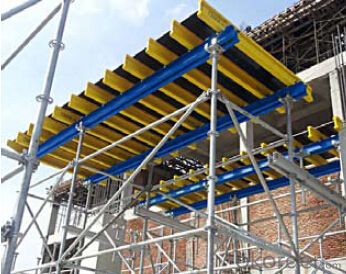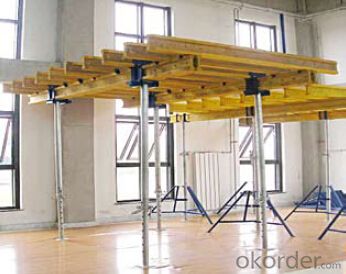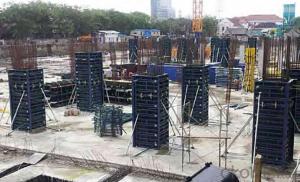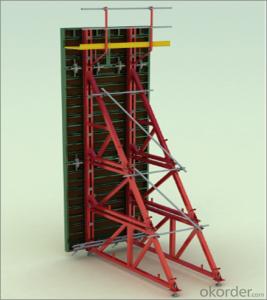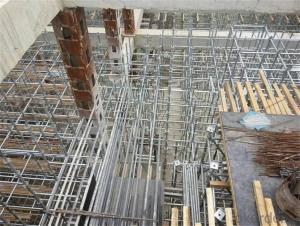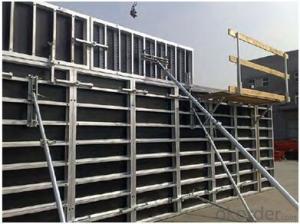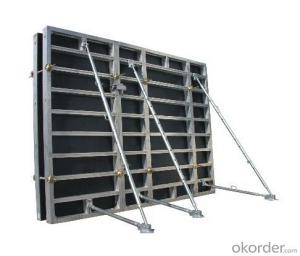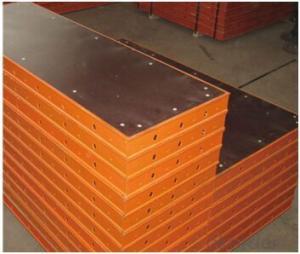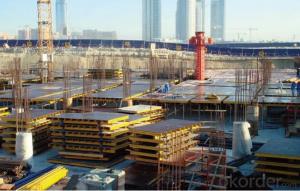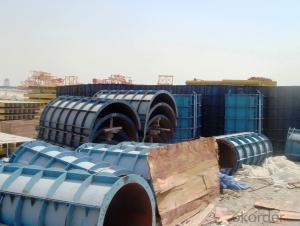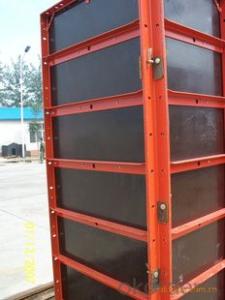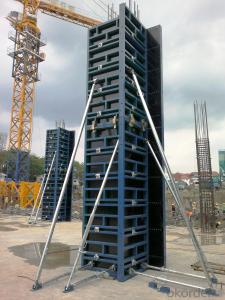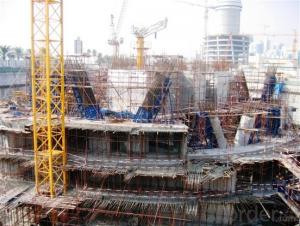Table formwork system for Build
- Loading Port:
- China Main Port
- Payment Terms:
- TT OR LC
- Min Order Qty:
- -
- Supply Capability:
- -
OKorder Service Pledge
OKorder Financial Service
You Might Also Like
Tabel Formwork:
Table formwork is the most typical application for slab, with timber beam, the slab formwork is
light weight, fast and economic in the construction.
Characteristics:
◆ Simple structure, easy assembly.
◆ Flexible structure, be adapted to different support system.
◆ High construction efficiency with special system tools.
1. Lifting fork for lifting the table formwork to upper floor.
2. Trolley for moving the table formwork on floor.
◆ Flexible application with stand alone props.
◆ Safer condition with handrails.
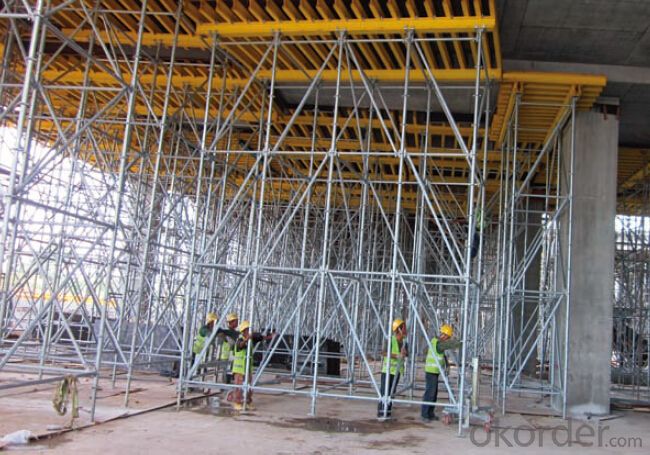
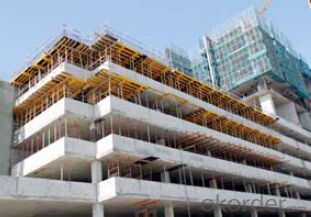
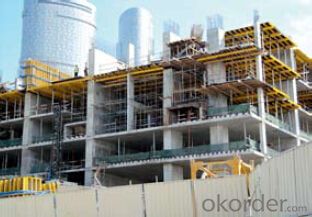
- Q: When the span of the main girder in steel frame is large, it is necessary to arrange the secondary beam
- Otherwise it would be uneconomical. Of course, we must meet the requirements of bearing capacity and deformation requirements.
- Q: High standard JGJ3-2002 article 5.2.3: in the vertical load, the frame can be considered when the end of the plastic deformation of the internal force redistribution, the negative moment of the beam multiplied by the amplitude modulation coefficient. The amplitude of the negative moment of the whole frame beam is 0.7 ~ 0.8, and the amplitude modulation coefficient of the negative moment of the frame beam at the end of the beam is expected to be from 0.8 to 0.9...
- The specific meaning of moment modulation:(1) the pursuit of conformity with reality(2) reduce the negative moment of Liang Duan, can reduce the negative moment reinforcement at the support, improve the condition of reinforced steel bar in the node area, which is convenient for concrete pouring, and ensure the strength of the node area.Principle: according to a certain proportion to reduce the bending moment of the beam; and then according to the balance conditions of the increase in the midspan moment.Moment amplitude modulation coefficient: 0.8~0.9 for cast-in-place frame; 0.7~0.8 for assembly frame;
- Q: What is the average lifespan of a steel frame formwork system?
- The average lifespan of a steel frame formwork system can vary depending on various factors such as the quality of the materials used, the frequency and intensity of usage, and the maintenance and care provided. Generally, a well-maintained steel frame formwork system can last for several years, ranging from 10 to 20 years or even longer. It is important to note that regular inspections and repairs, as well as proper storage and handling, can significantly extend the lifespan of the system. Additionally, factors such as weather conditions, exposure to corrosive agents, and proper load distribution can also impact the longevity of a steel frame formwork system.
- Q: How does steel frame formwork help in reducing material waste?
- Steel frame formwork helps in reducing material waste by providing a reusable and durable structure for concrete construction. Unlike traditional formwork made of timber or plywood, steel frame formwork can be used multiple times without deteriorating, thus minimizing the need for frequent replacement. This not only reduces the amount of material waste generated but also saves costs associated with purchasing new formwork for each construction project. Additionally, steel frame formwork offers better dimensional accuracy and stability, resulting in less concrete wastage during pouring and better quality construction overall.
- Q: How does steel frame formwork ensure proper concrete consolidation and compaction?
- Steel frame formwork ensures proper concrete consolidation and compaction by providing a rigid structure that holds the concrete in place during the pouring and curing process. The steel frame acts as a support system, preventing the concrete from sagging or deforming under its own weight. This ensures that the concrete remains in the desired shape and form, allowing for effective consolidation and compaction. Additionally, the steel frame formwork allows for the use of vibration equipment, which helps to further consolidate the concrete, removing any air voids and ensuring uniform compaction throughout the structure. Overall, steel frame formwork plays a crucial role in maintaining the integrity and quality of the concrete during the construction process.
- Q: Can steel frame formwork be used for both low-rise and high-rise buildings?
- Yes, steel frame formwork can be used for both low-rise and high-rise buildings. Steel frame formwork is a versatile and durable system that is capable of supporting the weight and pressure exerted by concrete during the construction process. It can be easily assembled and disassembled, making it suitable for various building heights. Additionally, the steel frame formwork can be adjusted and customized to accommodate different floor layouts and structural requirements. Its strength and stability make it an ideal choice for both low-rise and high-rise construction projects.
- Q: How does steel frame formwork contribute to faster construction times?
- Steel frame formwork contributes to faster construction times in several ways. Firstly, steel formwork is highly durable and can withstand the pressure and weight of concrete without warping or deforming. This means that it can be reused multiple times, reducing the time and effort required for formwork installation and removal. Additionally, steel frame formwork systems are designed to be easily assembled and disassembled, allowing for rapid construction and dismantling. The modular nature of these systems enables quick adjustments and modifications to the formwork configuration, saving time and ensuring accuracy. Furthermore, steel formwork provides a smooth and even surface finish, eliminating the need for additional plastering or finishing work. This saves both time and cost associated with the final touches of construction. Moreover, steel frame formwork allows for efficient pouring and curing of concrete. The tight joints and secure connections between the formwork elements ensure that the concrete is properly contained and shaped during the pouring process. This eliminates the need for additional support structures and minimizes the risk of concrete leakage or collapse. Overall, the strength, reusability, easy assembly, and efficient pouring capabilities of steel frame formwork contribute to faster construction times by reducing the labor and time required for formwork installation, providing a smooth surface finish, and facilitating rapid concrete pouring and curing processes.
- Q: Are there any specific considerations for using steel frame formwork in high-temperature environments?
- Yes, there are several specific considerations for using steel frame formwork in high-temperature environments. Firstly, steel has a high thermal conductivity, meaning it can easily transfer heat. In high-temperature environments, this can result in the steel frame formwork becoming extremely hot, which can pose a safety risk to workers. Therefore, it is important to take appropriate measures to protect workers from heat-related injuries, such as providing proper ventilation, shade, and personal protective equipment. Secondly, high temperatures can cause steel to expand, which may result in dimensional changes in the formwork. This can potentially affect the accuracy and quality of the concrete structure being formed. To mitigate this issue, engineers and contractors need to account for thermal expansion and design the formwork accordingly, considering factors such as the expected temperature range and the coefficient of thermal expansion of the steel used. Furthermore, high temperatures can also affect the strength and durability of the steel frame formwork. Prolonged exposure to high temperatures can lead to the loss of mechanical properties in the steel, such as reduced yield strength and increased susceptibility to deformation. Therefore, it is crucial to assess the suitability of the steel used in the formwork for high-temperature conditions and ensure that it meets the necessary standards and specifications. Additionally, it is essential to consider the potential for corrosion in high-temperature environments. Elevated temperatures can accelerate the corrosion process, especially in the presence of moisture or chemicals. To prevent corrosion, proper surface treatment and coating of the steel frame formwork should be applied, along with regular inspection and maintenance to identify and address any signs of corrosion. In summary, when using steel frame formwork in high-temperature environments, it is important to prioritize worker safety, account for thermal expansion, ensure the steel used is suitable for high-temperature conditions, and take measures to prevent corrosion. By addressing these specific considerations, the use of steel frame formwork can be optimized in high-temperature environments while maintaining safety and quality.
- Q: What are the key considerations for selecting the appropriate steel frame formwork system for projects with stringent quality requirements?
- When choosing the right steel frame formwork system for projects with strict quality requirements, there are several important factors to take into account. These factors include: 1. Material Quality: Ensuring that the steel used in the formwork system is of high quality and meets industry standards is crucial. This guarantees the durability and strength of the formwork system, which is essential for projects with strict quality requirements. 2. Design Flexibility: The formwork system should provide a high level of design flexibility to accommodate different project needs. It should be able to adapt to various shapes and sizes of structures, allowing for customization and precision in construction. This flexibility ensures that the formwork system can meet the specific quality requirements of the project. 3. Ease of Assembly and Disassembly: It is important for the formwork system to be easy to assemble and disassemble, as this impacts the efficiency and speed of construction. It should have a simple and intuitive design that facilitates quick and hassle-free installation. This reduces the chances of errors and allows for easy adjustments or modifications to the formwork system as needed. 4. Reusability: Another important factor to consider is the reusability of the formwork system. Projects with strict quality requirements often involve multiple concrete pours, and a reusable formwork system can significantly reduce costs and waste. It is important to select a system that can be easily taken apart, cleaned, and used again without compromising its structural integrity or quality. 5. Safety Features: Safety is a crucial aspect of any construction project, particularly those with strict quality requirements. The formwork system should have built-in safety features to protect workers during assembly, disassembly, and concrete pouring. This includes features like guardrails, non-slip surfaces, and secure anchoring systems. 6. Quality Assurance: It is important to choose a formwork system manufacturer with a strong track record of delivering high-quality products and providing reliable technical support. Selecting a reputable supplier who can provide the necessary documentation and certifications to ensure compliance with quality standards is essential. In conclusion, when choosing the appropriate steel frame formwork system for projects with strict quality requirements, it is important to consider factors such as material quality, design flexibility, ease of assembly, reusability, safety features, and the supplier's track record. By considering these key factors, one can ensure the selection of a formwork system that meets the highest quality standards and contributes to the successful completion of the project.
- Q: Can steel frame formwork be used for the construction of residential complexes?
- Residential complexes can indeed utilize steel frame formwork. This versatile and durable system offers numerous advantages for the construction of residential buildings. To begin with, the strength and stability provided by steel frame formwork make it suitable for the high-rise structures commonly found in residential complexes. The steel frames can withstand the weight and pressure exerted by concrete, ensuring the structural integrity of the building. Furthermore, steel frame formwork allows for faster construction compared to traditional formwork systems. The modular design of the steel frames enables swift assembly and disassembly, decreasing construction time and labor costs. This time-saving advantage is particularly beneficial for large-scale residential projects where efficiency and speed are of utmost importance. In addition, steel frame formwork offers flexibility in design. The system can be easily adjusted and modified to accommodate various architectural configurations and layouts, allowing for the creation of unique and aesthetically pleasing residential complexes. Moreover, steel frame formwork is highly durable and can withstand repeated use. This durability makes it a cost-effective solution for residential construction, as the formwork can be reused multiple times, reducing the need for additional materials and expenses. Lastly, steel frame formwork ensures excellent quality control. The system guarantees accurate and precise construction, resulting in a high-quality finish for residential complexes. This level of precision is crucial for creating safe and comfortable living spaces for residents. In conclusion, steel frame formwork is an efficient and suitable option for the construction of residential complexes. Its strength, speed, flexibility, durability, and quality control make it the ideal choice for developers and contractors aiming to construct residential buildings efficiently and effectively.
Send your message to us
Table formwork system for Build
- Loading Port:
- China Main Port
- Payment Terms:
- TT OR LC
- Min Order Qty:
- -
- Supply Capability:
- -
OKorder Service Pledge
OKorder Financial Service
Similar products
Hot products
Hot Searches
Related keywords
